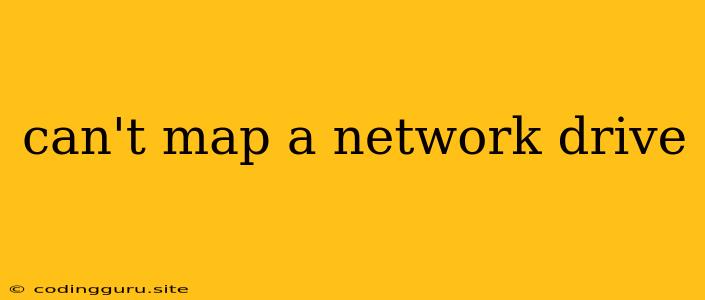Why Can't I Map a Network Drive? Troubleshooting Common Errors
Mapping a network drive is a fundamental task for many users, providing a convenient way to access files and resources shared on other computers. However, various problems can arise during this process, leaving you unable to successfully map the drive. This article will guide you through common errors encountered when mapping a network drive and offer solutions to help you overcome these challenges.
Understanding Network Drive Mapping
Before we delve into troubleshooting, it's crucial to understand the basic concepts of network drive mapping. Essentially, mapping a network drive assigns a local drive letter (like "Z:") to a shared folder or resource located on another computer on your network. This allows you to access the shared files and folders as if they were directly on your computer.
Common Errors and Solutions
Here are some common errors you might encounter when trying to map a network drive and practical solutions to address them:
1. Invalid Path or Network Name:
Problem: The most common issue is entering an incorrect path to the shared resource. This could involve a typo in the server name, share name, or even the path to the specific folder.
Solution:
- Double-check the server name and shared folder name: Ensure they are entered correctly without any typos.
- Verify network connectivity: Check if you can ping the server to ensure it's reachable on the network.
- Check the shared folder's path: The path should follow the format
\\server\sharenameor\\server\path\to\folder.
2. Incorrect Username or Password:
Problem: If the network drive requires authentication, you need to provide the correct username and password.
Solution:
- Use the appropriate credentials: Enter the username and password associated with the network account used to access the share.
- Check for account lockouts: If you repeatedly enter the wrong credentials, your account might be locked. Contact your network administrator to unlock it.
- Consider using domain credentials: If you are on a domain network, your domain login might be used for network drive mapping.
3. Network Drive Already Mapped:
Problem: You might attempt to map a drive letter that is already in use by another network drive.
Solution:
- Check for existing mappings: Open File Explorer (Windows) or Finder (macOS) and verify if the drive letter is already assigned.
- Disconnect the existing mapping: Right-click on the existing network drive and select "Disconnect."
- Re-map the drive: Attempt to map the desired drive letter again.
4. Access Permissions:
Problem: The user account you are using might not have the necessary permissions to access the shared folder.
Solution:
- Contact your network administrator: Request the appropriate permissions to access the shared folder.
- Check the folder sharing permissions: If you have administrative rights, check the sharing settings of the folder on the server to ensure the correct permissions are granted.
5. Firewall or Antivirus Blocking Access:
Problem: Your firewall or antivirus software might be blocking access to the shared folder.
Solution:
- Temporarily disable your firewall: This should help you determine if the firewall is the culprit. However, make sure to re-enable it after testing.
- Configure firewall exceptions: Allow access to the specific network location or port used by the shared folder.
- Check antivirus settings: Temporarily disable your antivirus software or configure it to allow access to the shared folder.
6. Incorrectly Configured Network Settings:
Problem: Problems with your computer's network configuration, like incorrect DNS settings or a faulty network adapter, can prevent network drive mapping.
Solution:
- Check your network settings: Ensure that your computer is connected to the correct network and that the network adapter is functioning correctly.
- Update your network drivers: Outdated network drivers can cause issues.
- Reset your network settings: Consider resetting your network settings to default values if you suspect a problem with network configuration.
7. Server Availability:
Problem: The server hosting the shared folder might be unavailable or offline.
Solution:
- Check server availability: Confirm that the server is online and running.
- Check for network outages: Verify if there are any issues with your network connection.
- Contact your network administrator: If you are unable to determine the cause of the unavailability, contact your network administrator for assistance.
Troubleshooting Tips
- Try connecting to the shared folder using the UNC path: You can access the shared folder directly using the UNC path (Universal Naming Convention) in the address bar of File Explorer.
- Run the Network Troubleshooter: Windows and macOS provide built-in troubleshooters that can help diagnose and resolve network issues.
- Check for error messages: Pay close attention to error messages displayed during the mapping process. These messages can provide clues about the specific problem.
- Use command line tools: Command line tools like 'net use' (Windows) or 'mount' (macOS) can be used to map network drives and provide more detailed error information.
Conclusion
Mapping a network drive can be a straightforward process, but errors can arise due to various reasons. By carefully analyzing the error messages and following the troubleshooting steps outlined in this article, you can identify and resolve common issues. Remember to verify network connectivity, user permissions, firewall settings, and server availability to ensure successful network drive mapping.
